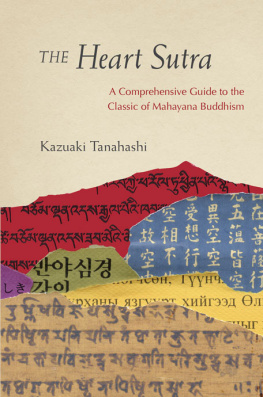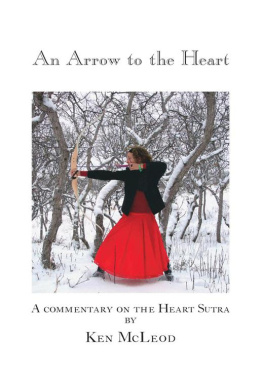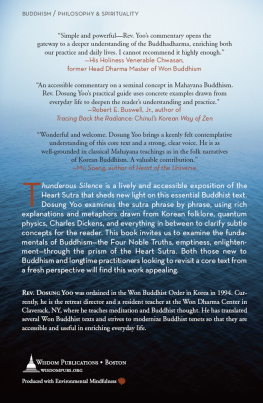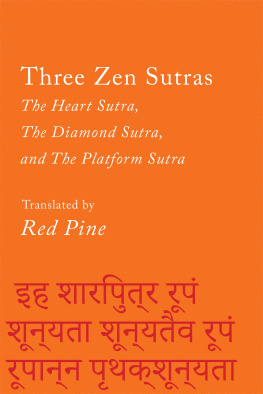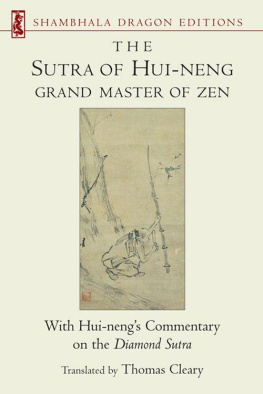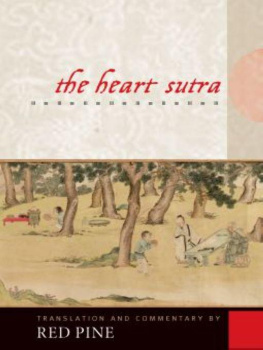For all who love the Dharma, Kazs study of the Heart Sutra is a true boonit serves us as introduction, history, toolbox, and treasure chest of teachings. It reads as a love story, a detective story, and yet it is a stunning scholarly resource. As inspiration, as reference, as deep study, this work is unsurpassable!
Roshi Pat Enkyo OHara, author of Most Intimate: A Zen Approach to Lifes Challenges
Kazuaki Tanahashi's Heart Sutra: A Comprehensive Guide to the Classic of Mahayana Buddhism delivers exactly what its subtitle promisesand much more. Most books on the sutra provide expositions of the by now well-known emptiness teachings (however, much of those teachings continue to resist our understanding). But such exposition, though lucidly present here, is the least of what this book offers. In addition, it traces the history of the text, its translation, and its dissemination throughout Asia and the West in ancient and modern times, and it includes a discussion of important and ground-breaking contemporary scholarship. It includes a biography of Xuanzhang, the sutras most famous Chinese translator, who famously journeyed to India to find it, as well as the recounting of a contemporary pilgrimage to a Korean monastery to see the oldest existing woodblock prints of the text. Its longest section is a line-by-line comparison of versions of the text in English and several Asian languages, full of useful nuance. In short, this astonishing work of loving scholarship, written with Kazs usual deft touch, is a must-have for any serious Dharma student.
Zoketsu Norman Fischer, poet, Zen priest, and author of Escape This Crazy Life of Tears and Training in Compassion: Zen Teachings on the Practice of Lojong
Tanahashis book on the Heart Sutra in its primarily Chinese and Japanese contexts covers a wide range of approaches to this most famous of all mahayana sutras. It brings the sutra to life through shedding light on it from many different angles, through presenting its historical background and traditional commentaries, evaluating modern scholarship, adapting the text to a contemporary readership, exploring its relationship to Western science, and relating personal anecdotes. The richness of the Heart Sutra and the many ways in which it can be understood and contemplated are further highlighted by his comparison of its versions in the major Asian languages in which it has been transmitted, as well as in a number of English translations. Highly recommended for all who wish to explore the profundity of this text in all its facets.
Karl Brunnhlzl, author of The Heart Attack Sutra: A New Commentary on the Heart Sutra
A masterwork of loving and meticulous scholarship, Kaz Tanahashis Heart Sutra is a living, breathing, deeply personal celebration of a beloved text, which all readersBuddhists and non-Buddhists, newcomers to the teaching and seasoned scholars alikewill cherish throughout time.
Ruth Ozeki, author of A Tale for the Time Being
ABOUT THE BOOK
The Prajnaparamita Hridaya Sutra is among the best known of all the Buddhist scriptures. Chanted daily by many Zen students, it is also studied extensively in the Tibetan tradition, and it has been regarded with interest more recently in the West in various fields of studyfrom philosophy to quantum physics. In just thirty-five lines, it expresses the truth of impermanence and the release from suffering that results from the understanding of that truth with a breathtaking economy of language. Kazuaki Tanahashis guide to the Heart Sutra is the result of a life spent working with it and living it. He outlines the history and meaning of the text and then analyzes it line by line in its various forms (Sanskrit, Chinese, Japanese, Korean, Tibetan, Mongolian, and various key English translations), providing a deeper understanding of the history and etymology of the elusive words than is generally available to the nonspecialistyet with a clear emphasis on the relevance of the text to practice. It includes a fresh and meticulous new translation of the text by the author and Roshi Joan Halifax.
KAZUAKI TANAHASHI, a Japanese-trained calligrapher, is the pioneer of the genre of one stroke painting as well as the creator of multicolor enso (Zen circles). His brushwork has been shown in solo exhibitions in galleries, museums, and universities all over the world. Tanahashi has edited several books of Dogen's writings and is also the author of Brush Mind.
Sign up to receive weekly Zen teachings and special offers from Shambhala Publications

Or visit us online to sign up at shambhala.com/ezenquotes.
THE
Heart Sutra
A Comprehensive Guide to the Classic of Mahayana Buddhism
KAZUAKI TANAHASHI

SHAMBHALA
Boston & London
2014
Shambhala Publications, Inc.
Horticultural Hall
300 Massachusetts Avenue
Boston, Massachusetts 02115
www.shambhala.com
2014 by Kazuaki Tanahashi
Cover art collage by Kazuaki Tanahashi.
The Sutra on the Heart of Realizing Wisdom Beyond Wisdom and the Ten-Line Sutra of Avalokiteshvaras have been put in public domain.
Except these texts, all rights are reserved.
All rights reserved. No part of this book may be reproduced in any form or by any means, electronic or mechanical, including photocopying, recording, or by any information storage and retrieval system, without permission in writing from the publisher.
LIBRARY OF CONGRESS CATALOGING-IN-PUBLICATION DATA
Tanahashi, Kazuaki, 1933
The Heart Sutra: a comprehensive guide to the classic of Mahayana Buddhism /
Kazuaki Tanahashi. First edition.
pages cm
Includes bibliographical references and index.
ISBN 978-1-61180-096-8 (hardcover: alk. paper) eISBN 978-0-83482-968-8 1. Tripitaka. Sutrapitaka.
Prajaparamita. Hrdaya Criticism, interpretation, etc. I. Tripitaka.
Sutrapitaka. Prajaparamita. Hrdaya. English. II. Title.
BQ1967.T35 2014
294.385 dc23
2013026815
To Peter Levitt
POETRY
DHARMA
FRIENDSHIP
Contents
Appendices
Fig. 1. (Map 1) Xuanzangs routes: ChinaIndia
I have consulted with general maps as well as Kazutoshi Nagasawa, trans. Genjo Sanzo: Saiiki Indo Kiko (Tripitaka Master Xuanzang: Central Asia and India Journal); and Sally Hovey Wriggins. The Silk Road Journey with Xuanzang.
Fig. 2. (Map 2) Xuanzangs routes: India
Same as above.
Fig. 3. Goryeo version of the Heart Sutra, print
Fig. 4. Prajna Paramita scripture, Gilgit fragment
Raghu Vira & Lokesh Chandra, eds., Gilgit Buddhist Manuscripts: Revised and Enlarged Compact Facsimile Edition.
Fig. 5. A stupa-shaped Heart Sutra
Discovered at Dunhuang Cave. A collection of the National Library of Paris. Pelliot, #2168.
Fig. 6. Horyu-ji version of Hridaya
A collection of Tokyo National Museum. Baiy Bompon Shingy. Film: C42609.
Fig. 7. A Chinese transliteration of Hridaya
Discovered at Dunhuang Cave. Portion. A collection of the British Library. Stein #5648.
Fig. 8. The earliest known rendering of the Heart Sutra
Carved in 672. Stone rubbing. Public domain.
Fig. 9. Roots of European and Indian scripts
Excerpted from Shuyo Takubo and Shoko Kanayama, Bonji Shittan (Sanskrit and Siddham Scripts), fig. 1.
Fig. 10. Hridaya in Tibetan
Recovered from the sTog Palace near the city of Leh in present-day Ladakh. Copied during the reign of Jamyang Namgyal in the early seventeenth century. Courtesy of the Tibetan Buddhist Resource Center, New York City.
Next page
